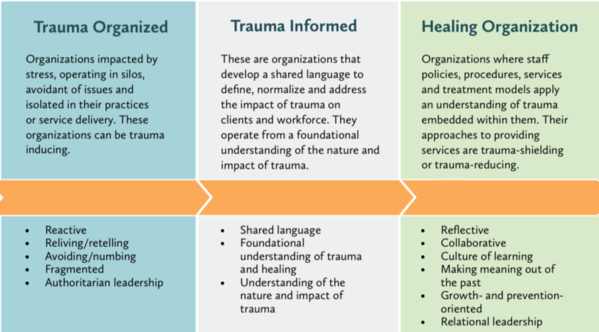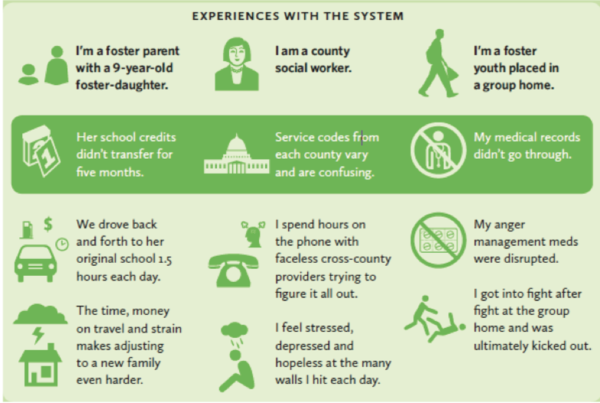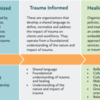The talk around the table is not what one might expect when community advocates begin a meeting with county health officials.
“I went into this [work] through my own lived experience of trauma and family addiction,” said Toni DeMarco, the deputy director of children’s services for San Mateo County Health System.
Rocsana Enriquez, who teaches yoga to teens in juvenile hall in San Mateo and Santa Clara counties and in high schools for the Palo Alto-based Art of Yoga Project , chimed in. “I’m here because I was in the juvenile justice system and I have trauma in my family background.” Enriquez also works with the youth leadership organization, Youth in Mind.
For Gerold Loenicker, the program manager for Child & Adolescent Behavioral Health in the Contra Costa Behavioral Health/Central County Children’s Programs, the response to the question was also personal: “What brought me to this work was my own experience with trauma and resilience in my family background."
The question of what had brought everyone to this work was posed to all attending Trauma Transformed’s Oversight and County Directors meeting at the program’s Oakland offices. It included advocates from several community organizations and children’s behavioral health directors from six Bay Area counties, including Contra Costa, San Francisco, San Mateo, Alameda, Marin and Santa Clara.
While their current roles in the community may differ, they were all there with a particular abiding interest: to participate in a paradigm shift to trauma-informed and healing practices across all sectors in their counties.
That effort has already been underway since 2014, thanks to a four-year, $4 million federal grant awarded to the San Francisco Department of Public Health by the U.S. Substance Abuse and Mental Health Services Administration (SAMHSA). Trauma Transformed, a program of the East Bay Agency for Children, emerged as the connector for the seven Bay Area Counties receiving the SAMHSA grant, which also includes Santa Cruz. Partnering organizations for the grant include the Center for Youth Wellness; the organization founded by pediatrician Dr. Nadine Burke Harris; the California-based Youth in Mind and the UCSF Benioff Children’s Hospital in Oakland.
The children’s behavioral health directors of seven Bay Area counties reasoned that if their agencies were going to be able to keep their workforce from burning out — and providing much-needed services to their clientele — who often are marginalized, poor, and have survived lifetimes of trauma, the county program directors realized they have to adopt a radically different approach to training their workforce.
“If there are no methods in place to take care of the workforce,” said Loenicker, “the employees burn out, which in turn has an effect on the consumers we serve. The trauma-informed system effort is a response to that.”
In its role as connector, Trauma Transformed (also known as T2) guides counties on policy and trains trainers in the curriculum of trauma-informed care developed by the San Francisco Department of Public Health. The goal is to ultimately train every county employee “from janitor to judge”, as Loenicker put it.
San Francisco Department of Public Health
That may seem like a tall order for the untold thousands of workers in the seven counties. However, Trauma Transformed and the San Francisco Department of Public Health have already together trained more than12,000 people in the basic principles of trauma-informed care. They’ve been able to do so by training groups of lead trainers who then train their workforces. The Trauma-informed Systems 101, a 3.5 hour training, includes how trauma affects the developing brain and body, and impacts communities and systems, according to a description of the training on the Santa Clara County website. (Other than how toxic stress affects the brain and body, however, it does not include training on the science of adverse childhood experiences.)
Loenicker said that a notable takeaway from the trauma training among his workforce was asking each participant to commit to making a few small changes in their daily practices at work. He ticked off a few examples:
- Incorporate mindful moments into meetings
- Make time to dwell on successes and appreciation
- Be aware when writing emails to avoid misunderstandings, since tone can easily be misconstrued.
Jeff Rackmil, the director of Child and Young Adult System of Care at the Alameda County Behavioral Health Care Services, said that he had some similar takeaways. He now begins leadership meetings with two minutes of silence for people to “get centered.”
Another involves being more conscious that his team can express concerns – whatever they may be. “You want to be able to read the emotional field of the team. In meetings sometimes things can come up, and you think you’ve resolved it, and you look around and see that people have this look on their face. If you don’t deal with it then, it comes out sideways later.”
For Rocsana Enriquez, her experience in trauma-informed practices began when she was in juvenile hall in San Mateo around a decade ago. That’s where she first was introduced to trauma-informed yoga, a program developed by the Palo Alto-based The Art of Yoga Project, where she now teaches.
In order to give the girls a sense of control, she says, “We use a gentle voice and suggest poses. We don’t want them to feel like they’re being forced to do them.” She says she also checks in with teens to see how they are feeling while doing various yoga poses. All of these strategies, says Enriquez, who is preparing for entrance exams for law school, are meant to reassure the girls that they’re not being judged.
That same sensibility is part of an essential ingredient that T2 brought to their role of helping to reshape systems so that they’re trauma-informed: That youth and caregivers whose lives have been affected by social service agencies help guide changes so that their peers’ needs are better met.
One of the first projects that the seven counties tackled with input from workers, youth and families was remedying problems in the foster care system. In 2015, approximately 20 percent of foster care youth in California were placed in a different county than their home county, according to data gathered by the University of California at Berkeley’s California Child Welfare Indicators project and reported in the Chronicle of Social Change. This is because counties typically don’t have shared systems in place to communicate with one another.
Not surprisingly, children in the foster care system are already vulnerable. According to a recent article in the journal Children and Youth Services Review, 70 percent of women who had been in foster care had adverse childhood experience (ACEs) scores of 5 or more.
ACEs comes from the CDC-Kaiser Permanente Adverse Childhood Experiences Study (ACE Study), groundbreaking research that looked at how 10 types of childhood trauma affect long-term health. They include physical, emotional and sexual abuse; physical and emotional neglect; living with a family member who’s addicted to alcohol or other substances, or who’s depressed or has other mental illnesses; experiencing parental divorce or separation; having a family member who’s incarcerated, and witnessing a mother being abused.
In Trauma Transformed’s survey of county workers, youth and caregivers in focus groups and interviews, they learned a number of disconnects occurring in out-of-county placements of foster youth that were hurting instead of helping them.
Examples included a caregiver having to drive her foster daughter up to five hours a day to her former school because school credits hadn’t been transferred. In another case, a foster youth whose medical records didn’t follow him to a group home disrupted medication that helped curb his angry outbursts; this failure caused him to get kicked out of a group home because of fights.
Workers trying to help these foster youth also reported feeling overwhelmed. One social worker, for example, described feeling hopeless and depressed because of the many hours spent trying to contact counterparts in other counties to help her decipher their coding. (These examples are detailed in the excerpted chart below, and in a separate report.)
Connecting Youth Placed Out of County to Trauma Informed Care, by Be the Change consulting for T2
To begin solving these problems, Trauma Transformed helped form a team of representatives from each county to analyze data that follows youth placed in other counties, and they set up a GIS mapping guide that tracks out of county placements, according to the attached reports.
While they’re trying to create a way for counties to communicate with one another, T2’s most recent report notes, there have been roadblocks: “While having formal data sharing agreements would unlock great potential for collaboration and streamlining of care, there are deep rooted concerns and entrenched practices regarding privacy regulations, information sharing, and HIPAA compliance that have stood in the way to date.”
That there are challenges is to be expected in any big shift. Regardless of challenges, T2 Executive Director Jen Leland says:
“By creating spaces where we can explore trauma at the community, collective, structural and institutional level, we begin to see this is about us, and we begin to feel empowered to find pathways for healing at the collective level. The promise of ACES science really begins to impact all of us, and especially those most vulnerable. It’s not a therapist referral, it’s a way to build healing systems of care that can improve all of our lives.”





Comments (0)